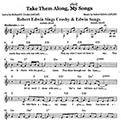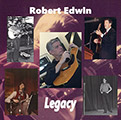Welcome to the Robert Edwin Studio!
Robert Edwin Studio est. 1975 — Robert Edwin est. 1946
Supplemental Singing Exercises
Supplement to the Oxford Handbook of Music Education (2011) - Young Singer Chapter - Chapter authors: R. Edwin, K. Phillips, J. Williams.Supplemental Singing Exercises by Robert Edwin
for the Young Singer Chapter
Oxford University Press Handbook of Music Education
Chapter authors: K. Phillips, J. Williams, R. Edwin
(To be published in 2011)
Singing exercises for CHILDREN and TEENS
Most, if not all singing styles can employ the abdominally-supported breath management techniques described earlier in the chapter. There should be no argument from anyone about a predictable and efficient power source - no pointing to artists, classical or pop, who are the exception rather than the rule and who are used by singers as excuses for their own bad breathing habits.
The phonation source (the vocal folds), on the other hand, should employ many options. Dancers don’t train only one side of their bodies, yet many singers only use one part of their voice. Child belters are often without an upper register and children in choirs are often without a lower register. Whether that is the result of personal choice or teacher-imposed direction, voice science and modern voice pedagogy agree that using one register without the other prevents the voice from reaching its full potential. The CT and TA muscles ("head" and "chest" in traditional terminology) work in concert. One group helps the other. Therefore, voice educators should have child students isolate and integrate lower and upper register activity. For example, have them sing a one-three-one (do-mi-do) pattern in their CT head voice-dominant register by singing the phrase, "up-per voice" (one syllable per note) starting at E4 (E above middle C). The quality should be bright and speech-like. Next, have them sing the same pattern in their TA chest voice-dominant register singing the phrase, "low-er voice" starting at A3 (A below middle C). Many children will be able to carry that pattern in their belt/mix up to and even beyond C5. Again, the tone quality should be bright and conversational in nature so that it doesn’t overload the system. Finally, have them sing the phrase, "blend-ed voice" using an octave pattern starting at A3 in the lower voice and going to A4 in the upper voice. Move the exercise up in half steps. At first, some children might be limited to one register. Encourage them to use both even if it sounds like two different people singing. Achieving a higher level of coordination can be a long and winding road. Muscles take time to learn what to do. The more the muscles of singing can do, the better the results no matter what style of singing is engaged. Be patient!
The amplification source, (the throat, mouth and nose resonators), can also benefit from some "cross training" work (Edwin 2008). In classical singing, the pharynx usually widens while the larynx lowers a bit creating more resonance space. In most forms of Contemporary Commercial Singing (CCM), the throat narrows and the larynx raises a bit creating a more speech-like tonal quality.
Teachers can have their singers explore the extremes of resonance with an exercise called," The Wicked Witch Meets the Cowardly Lion." On a descending five note diatonic scale, ask the singers to sound like the wicked witch in The Wizard of Oz using a "heh, heh, heh, heh, heh" lyric. It should be a highly nasalized sound created by lowering the soft palate and narrowing the rest of the resonance space. No exercise should be done passively without emotional support, so encourage them to "get into it" with witchy finger pointing and congruent body language.
Next, ask them to find their cowardly lion voice. This time the lyric is a very woofy and heavy, "ho, ho, ho, ho, ho." The soft palate is up, the pharynx is wide, and the larynx is down. These are fun sounds not pretty sounds and they stretch the muscles as well as the mind.
Finally, tell the kids that they’ve sent their witch and their lion off for singing lessons. Ask them to sing the "heh" and "ho" lyrics again with a new, more balanced sound. The extremes brought into the middle can create a very dynamic resonance spectrum. Be sure to do the exercise in both registers.
Articulation, or diction as it is commonly called, is very style dependent. Cleanly articulated choir singing is a must for clarity of text. That same articulation approach in CCM singing, however, can often sound unnatural and stylistically inappropriate. Prepare your singers for multiple styles through another extreme exercise called, "Neat and Sloppy." Start with an up and down five note scale ( do to sol) with the phrase, "this is ver-y neat," with the descending sol to do on the word, "neat." Ask them to overstress every consonant and vowel, especially the last "t." Then, have them sing the phrase, "this is very slop-py," with no accents or stress on any vowel or consonant, especially the consonants. The exercise can then go to variations of each extreme – sort of neat and sort of sloppy. The balance in the middle is defined by the extremes on the outside. Once again, silly exercises reinforce important and powerful singing techniques that serve a multitude of singing styles.
Singing exercises just for TEENS
Training the entire voice to maximize its potential has its challenges when teaching adolescents. Pubescent boys developing their new-found masculinity might be reluctant to continue using their crico-thyroid-dominant register now that it is called false (falsetto) and is associated with "sounding like a girl." Pubescent girls, on the other hand, are often more than glad to embrace their thyro-arytenoid-dominant register because most CCM music requires it. Their and their teachers’ challenge is to counter balance that vocal fold activity with a significant amount of CT exercises.
To that end, vocalizations in both registers can confront the gender/cultural issues straight on. For example, if a voice-changed "manboy" still has an upper register that is functional, ask him to sing on a single note, let’s say A4, the phrase, "the CT is a muscle and I am not a girl." If nothing comes out but air or if he tries to sing in a TA-dominant voice, plan B would be a simple "hoo" like an owl, a male one, of course. Activating or reactivating the CT muscle is critical to keeping the voice in balance and in shape (Brown 1990). A reluctant "womangirl" who views the lower register as "sounding like a boy" can do a similar exercise singing, "the TA is a muscle and I am not a boy," on the one note A3 using the aforementioned TA.
RESEARCH AND PEDAGOGICAL OPINION ARTICLES, BOOKS AND VIDEOS RELEVANT TO YOUNG SINGERS
Research Articles:
Aaron, J. (1993). Using vocal coordination instruction to help the inaccurate singer.
Update: Applications
of Research in Music Education, 11(2), 8-13.
Adler, A.(1999). A survey of teacher practices in working with male singers
before and during the voice change.
Canadian Journal of Research
in Music Education, 40(4), 29-33.
American Academy of Teachers of Singing (2002). Teaching children to sing:
A Statement by the American
Academy of Teachers of Singing.
Retrieved from http://www.amaericanacademyofteachers.org.
Atterbury, B. W., & Silcox, L. (1993a). The effect of piano accompaniment
on kindergartners' developmental.
singing ability Journal of
Research in Music Education, 41(1), 40-47.
Atterbury, B. W. & Silcox, L. (1993b). A comparison of home musical
environment and musical aptitude
in kindergarten students.
Update: Applications of Research in Music Education, 11(2), 18-21.
Barlow, C. A., & Howard, D. (2002). Voice source changes of child and
adolescent subjects undergoing singing
training - a preliminary
study. Logopedics Phoniatrics Vocology, 27, 66-73.
Barlow, C. A., & Howard, D. (2005). Electrolarygographically derived
voice source changes of child and
adolescent singers.
Logopedics Phoniatrics Vocology, 30 (3-4), 147-157.
Blatt, I. M. (1983). Training singing children during the phases of voice mutation.
Annals of Otology, Rhinology,
Laryngology, 92, 462-468.
Boardman, E. L. (1964). An investigation of the effect of preschool training
on the development of vocal accuracy
in young children (Doctoral
dissertation, University of Illinois). Dissertation Abstracts, 25, 1245.
Bonet, M., & Casan, P. (1994). Evaluation of dysphonia in a children's choir. Folia Phoniatrica, 46, 27-34.
Böhme, G., & Stuchlick, G. (1995). Voice profiles and standard voice
profile of untrained children. Journal of Voice,
9(3), 304-307.
Chinn, B. J. (1997). Vocal self-identification, singing style, and singing range
in relationship to a measure of cultural
mistrust in African-American
adolescent females. Journal of Research in Music Education, 45(4), 636-649.
Cooksey, J. M. & Welch, G. F. (1998). Adolescence, singing development and
national curricula design.
British Journal of Music Education,
15(1), 99-119.
Cooper, N. A. (1995). Children's singing accuracy as a function of grade level,
gender, and individual versus
unison singing. Journal of Research
in Music Education, 43(3), 222-231.
Demorest, S. M. (2001a). Pitch-matching performance of junior high boys:
A comparison of perception and
production. Bulletin of the
Council for Research in Music Education, 151, 63-70.
Daugherty, J., & Hedden, D. (2006). Audition procedures for community-based
children's choirs. Bulletin of the
Council for Research
in Music Education, 167, 33-45.
Demorest, S. M. & Clements, A. (2007). Factors influencing the pitch-matching
of junior high boys. Journal of
Research in Music
Education, 55(2), 115-128.
Dickey, M. R. (1992). A review of research on modeling in music teaching and learning.
Bulletin of the Council
for Research in Music
Education, 113, 27-40.
Durrant, C. (2000). Making choral rehearsal seductive: implication for practice
and choral education. Research
Studies in Music
Education, 15, 40-49.
Edwin, R. (2009). Auditioning 101. Journal of Singing, 66 (2), 181-182.
Edwin, R. (1987). Care and feeding of young voices. The NATS Journal, 43 (4), 44.
Edwin, R. (2002). Children are singing. Perspectives on Voice and Voice Disorders, 12 (2), 11-14.
Edwin, R. (2008). Cross training for the voice. Journal of Singing, 65 (1), 73-76.
Edwin, R. (1989). Influences and choices: a story. The NATS Journal, 45 (5), 28.
Edwin, R. (1992). Kids are singers, too. The NATS Journal, 50 (2), 51-52.
Edwin, R. (1990). Out of the mouths of babes. The NATS Journal, 46 (3), 38.
Edwin, R. (2002). Should my child major in the performing arts? Journal of Singing, 58 (5), 441-442.
Edwin, R. (1990). Teaching one’s own. The NATS Journal, 46 (5), 35.
Edwin, R. (2004). The singing teacher as advocate. Journal of Singing, 61 (1), 79-81.
Edwin, R. (1997). The three ages of voice: the singing teacher as vocal parent. Journal of Voice, 11 (2), 135-137.
Edwin, R. (2001). Vocal exercises for children of all ages. Journal of Singing, 57 (4), 49-51.
Edwin, R. (1995). Vocal parenting. The NATS Journal, 51 (3), 53-56.
Edwin, R. (1995). Voice, how do we abuse thee…? Journal of Singing, 52 (1), 65-66.
Edwin, R. (1999). Voice of an angel. Journal of Singing, 56 (2), 49-51.
Emge, S. W. (1998). The adolescent male: Vocal registers as affecting vocal range,
register competence, and comfort
in singing. The Center Review
(Northeastern State University, Tahlequah, OK), 7(1), 1-12.
Fett, D. L. (1993/1994). The adolescent female voice: The effect of vocal skills
instruction on measures of singing
performance and breath management
(Doctoral dissertation, The University of Iowa). Dissertation Abstracts
International, 54(07), 2501A.
Freer, P. (2009). Choral Warm-Ups for Changing Adolescent Voices. Music Educators Journal 95 (3), 57-62.
Freer, P. (2006). Hearing the voices of adolescent boys in choral music: A self-story.
Research Studies
in Music Education, 27, 69.
Retrieved October 29, 2008, at http://rsm.sagepub.com/cgi/content/abstract/27/1/69.
Fuchs, M., Fröhlich, M., Hentschel, B., Stuermer, I., Kruse, E., &
Knauft, D. (2007). Predicting mutational change
in the speaking
voice of boys. Journal of Voice, 21(2), 169-178.
Gault, B. (2002). Effects of pedagogical approach, presence/absence of text, and
developmental music aptitude on
the song performance accuracy
of kindergarten and first-grade students. Bulletin of the Council for Research in
Music Education, 152, 54-63.
Goetze, M. (1985/1986). Factors affecting accuracy in children’s singing (Doctoral
dissertation, University of
Colorado at Boulder). Dissertation
Abstracts International, 46, 2955A..
Goetze, M., Cooper, N., & Brown, C. (1990). Recent research on singing in the general
music classroom. Bulletin of
the Council for Research in
Music Education, 104, 16-37.
Green, G. (1990). The effects of vocal modeling on pitch-matching accuracy of
elementary school children. Journal of
Research in
Music Education, 38(3), 225-231.
Green, G. (1994). Unison versus individual singing and elementary students' vocal pitch
accuracy. Journal of
Research in Music Education,
42(2), 105-114.
Grimland, F. (2006). Characteristics of teacher-directed modeling in high
school choral rehearsals. Update:
Applications of Research in Music
Education, 24(1), 5-14.
Guerrini, S. (2006). The developing singer: Comparing the singing accuracy of
elementary students on three
selected vocal tasks. Bulletin
of the Council for Research in Music Education, 167, 21-31.
Guilbault, D. (2004). The effect of harmonic accompaniment on the tonal achievement
and tonal improvisations of
children in kindergarten and first grade.
Journal of Research in Music Education, 52(1), 64-76.
Harries, M. L., Hawkins, S., Hacking, J., & Hughes, I. (1998). Changes in the
male voice at puberty: vocal fold length
and its relationship to the
fundamental frequency of voice. The Journal of Laryngology and Otology, 112, 451-454.
Hendley, J. A. & Persellin, D. C. (1996). How the lower adult male voice and the male
falsetto voice affect children’s
vocal accuracy. Update:
Applications of Research in Music Education, 14(2), 9-14.
Henry, J. E. (1995). The effectiveness of Kenneth Phillips' strategies on the singing
development of students in grade 5.
Unpublished master's thesis, The Pennsylvania State University,
College Park. Herman-Giddens, M.E., Slora, E.J.,
Wasserman, R.C., Bourndony, C.J., Bhapkar,
M.V., Kock, G.G., & Hasemeier, C.M. (1997). Secondary sexual
characteristics and menses in young girls seen in office practice:
A study from the Pediatric Research in Office
Settings Network. Pediatrics, 99 (4), 505-512.
Hornbach, C. M. & Taggart, C. C. (12005). The relationship between developmental
tonal aptitude and singing
achievement among kindergarten, first-, second-,
and third-grade students. Journal of Research in Music
Education, 53(4), 322-331.
Hoit, J. D., Hixon, T. J., Watson, P. J., & Morgan, W. J. (1990).
Speech breathing in children and adolescents.
Journal of Speech
and Hearing Research, 33, 51-69.
Hollien, H., Green, R., & Massey, K. (1994). Longitudinal research on
adolescent voice change in males. Journal of
the Acoustical
Society of America, 96, 2646-2654.
Howard, D. M. & Welch, G. F. (2002). Female chorister voice development: A
longitudinal study at Wells, UK.
Bulletin of the Council for Research
in Music Education, 153/4, 63-70.
Howe, M. J. A., & Sloboda, J. A. (1991). Young musicians' accounts of significant
influences in their early lives. 1.
The family and the musical background.
British Journal of Music Education, 8, 39-52.
Howle, M.J. (1992). An examination of selected aspects of pitch problems among children.
Research Perspectives
in Music Education 3, 22-27.
Huff-Gackle, M. L. (1985). The adolescent female voice (ages 11-15): Classification,
placement and development
of tone. Choral Journal, 25(8), 15-18.
Kahane, J. C. (1982). Growth of the human prepubertal and pubertal larynx.
Journal of Speech and Hearing
Research, 25, 446-455.
Kaplowitz, P.B., Slora, E.J., Wasserman, R.C., Pedlow, S.E, & Herman-Giddens. (2001).
Earlier onset of puberty
in girls: Relation to increased body mass index and race.
Pediatrics 108(2), 347-353.
Kennedy, M. A. (2002). “It’s cool because we like to sing”:
Junior high school boys’ experience of choral music
as an elective. Research Studies in Music Education 18, 24-34.
Kennedy, M. C. (2004). “It’s a metamorphosis”:
Guiding the voice change at the American Boychoir School.
Journal of Research in Music Education, 52(3), 264-280.
Kent, R. D., & Vorperian, H. K. (1995). Development of the
craniofacial-oral-laryngeal anatomy: a review. Journal
of
Medical Speech-Language Pathology, 3(3), 145-190.
Killian, J. (1997). Perceptions of the voice-change process: Male adult versus adolescent
musicians and
nonmusicians. Journal of Research in Music
Education, 45(4), 521-535.
Killian, J. (1999). A description of vocal maturation among fifth- and sixth-grade boys.
Journal of Research in Music
Education, 47(4), 357-69.
Livesey, J., & Carding, P. (1996). Puberphonia or the male voice that will not break.
Australian Voice.
Levinowitz, L. M., Barnes, P., Guerrini, S., Clement, M.,
D'April, P., & Morey, M. J. (1998). Measuring singing
voice development in the elementary general music classroom.
Journal of Research in Music Education, 46(1),
35-47.
Mang, E. (2006) Effects of age, gender and language on children’s singing
competency.British Journal of Music
Education 32(2),
161-174.
Marshall, H. D. III (2002). Effects of song presentation method on pitch accuracy of
third-grade children (Doctoral
dissertation, Temple University).
Dissertation Abstracts International, 64(01), 91A.
McAllister, A., Sundberg, J., & Hibi, S. R. (1998). Acoustic measurements and perceptual evaluation of hoarseness in children's voices. Logopedics Phoniatrics Vocology, 23, 27-38.
McGuire, K. M. (2000). Common songs of the cultural heritage of the United States: A
compilation of songs that
most people "know" and "should know."
Journal of Research in Music Education, 48(4), 310-322.
Moore, R. (1994). Effects of age, sex, and melodic/harmonic patterns on vocal pitch-
matching skills of talented
8-11 year-olds. Journal of Research in
Music Education, 42(1), 5-13.
Moore, R., Brotons, M., Fyk, J., & Castillo, A. (1997). Effects of culture, age, gender,
and repeated trials on rote
song learning skills of children 6-9 years old from
England, Panama, Spain and the United States. Bulletin of the
Council for Research in Music Education, 133, 83-88.
Moore, S., Chen, H., & Brotons, M. (2004). Pitch and interval accuracy in echo singing
and xylophone playing by 8
and 10 year-old children from England, Spain, Taiiwan, and U.S.A.
Bulletin of the Council for Research in Music
Education,161-62, 173-180.
Moore, R. Fyk, J., Frega, A., & Brotons, M. (1995/1996). Influence of culture, age,
gender, and two-tone melodies
on interval matching skills of children from
Argentina, Poland, Spain, and the U.S.A. Bulletin of the Council for
Research in Music Education, 127, 127-135.
Pedersen, M. F., Møller, S., Krabbe, S., Munk, E., & Bennett, P. (1985).
A multivariate statistical analysis of voice
phenomena related to
puberty in choir boys. Folia Phoniatrica, 37, 271-278.
Persellin, D. C. (2006). The effects of vocal modeling, musical aptitude, and home
environment on pitch accuracy
of young children.
Bulletin of the Council for Research in Music Education, 169, 39-50.
Phillips, K. H. (1985). The effects of group breath control training on selected vocal
measures related to the
singing ability of elementary students.
Journal of Research in Music Education, 33(3), 179-191.
Phillips, K. H. (1992a). Research on the teaching of singing, in Colwell, R. (Ed.),
Handbook of research on music
teaching and learning,
New York: Schirmer Books, 568-576.
Phillips, K. H. (1992b). Teaching kids to sing. New York: Schirmer Books.
Phillips, K. H. & Aitchison, R. E. (1997a).
The relationship of
inaccurate singing to pitch discrimination and tonal aptitude among third-grade students.
Contributions to Music Education, 24(1), 7-22.
Phillips, K. H. & Aitchison, R. E. (1997b). Effects of psychomotor instruction on
elementary general music students'
singing performance.
Journal of Research in Music Education, 45(2), 185-196.
Phillips, K. H. & Aitchison (1998). The effects of psychomotor skills instruction on
attitude towards singing and
general music among students in grades 4–6.
Bulletin of the Council for Research in Music Education, 137, 32-42.
Phillips, K. H. & Aitchison, R. E. (1999). Second-year results of a longitudinal study of
the relationship of singing
instruction, pitch accuracy, and gender
to aural acuity, vocal achievement, musical knowledge, and attitude
towards singing among general music students.
Contributions to Music Education, 26(1), 67-85.
Phillips, K. H., Aitchison, R. E., Bergman, J. F. & Western, B. A. (1999). First-year
results of a study relating singing
instruction, pitch accuracy,
and gender to aural acuity and vocal achievement among general music students.
Research Perspectives in Music Education, 1, 32-37.
Phillips, K. H., Aitchison, R. E. & Nompula, Y. P. (2002). The relationship of music
aptitude to singing achievement
among fifth-grade students.
Contributions to Music Education, 29(1), 47-58.
Phillips, K. H. & Fett, D. L. (1992). Breathing and its relationship to vocal quality
among adolescent female singers.
Journal of Research in Singing and
Applied Vocal Pedagogy, 15(2), 1-12.
Price, H. E., Yarbrough, C., Jones, M., & Moore, R. S. (1994). Effects of male timbre,
falsetto, and sine-wave models
on interval matching by inaccurate singers.
Journal of Research in Music Education, 42(4), 269-284.
Rinta, T., & Welch, G. (2008). Should singing activities be included in speech
and voice therapy for prepubertal
children?
Journal of Voice, 22(1), 100-112.
Rogol, A.D., Roemmich, J.N., & Clark, P.A. (2002). Growth at Puberty.
Journal of Adolescent Health, 31(6) suppl.,
192-200.
Ross, W. E. (1948). Sing high, sing low. Bloomington, IN: Indiana University Press.
Rutkowski, J. (1990). The measurement and evaluation of children's singing voice
development. The Quarterly:
Center for Research in Music
Learning and Teaching, 1(1-2), 81-95.
Rutkowski, J. (1996). The effectiveness of individual/small group singing activities on
kindergartners' use of singing
voice and developmental music aptitude.
Journal of Research in Music Education, 44(4), 353-368.
Rutkowski, J. & Chen-Haftek, L. (2001). The singing voice within every child:
A cross-cultural comparison of first
graders use of singing voice.
Early Childhood Connections: Journal of Music-and-Movement-Based Learning,
7(1), p. 37-42.
Rutkowski, J. & Miller, M. S. (2003a). A longitudinal study of elementary children's
acquisition of their singing voices.
Update: Applications of
Research in Music Education, 22(1), 5- 14.
Rutkowski, J. & Miller, M. S. (2003b). The effectiveness of instruction and
individual/small group singing activities
on first graders' use
of singing voice and developmental music aptitude. Contributions to Music Education,
30(1), 23-28.
Rutkowski, J. & Miller, M. S. (2003c). The effects of teacher feedback and modeling on
first graders’ use of singing
voice and developmental music aptitude.
Bulletin of the Council for Research in Music Education, 156, 1-10.
Sargeant, D., Sjölander, P., & Welch, G. (2005). Listeners' identification of gender
differences in childrens' singing.
Research Studies
in Music Education, 24, 28-39.
Sargeant, D., & Welch, G. (2008). Age-related changes in long-term average spectra of
children's voices.
Journal of Voice, 22(6), 658-670.
Sataloff, R., & Spiegel, J. (1989). The Young Voice. Journal of Singing, 45(3), 35-37.
Sederholm, E. (1995). Prevalence of hoarseness in ten-year-old children. Scandinavian
Journal of Logopedics
and Phoniatrics, 20, 165-173.
Sherburn-Bly, R. (2007). Straight tone in the choral arts: A simple solution. Choral Journal, 47(8), 61-69.
Schiff, M.B. (1999). Sex hormones and the female voice. Journal of Voice 13(3), 424-443.
Siebenaler, D. (2008). Children’s attitudes toward singing and song recordings
related to gender, ethnicity, and
age. Update: Applications of
Research in Music Education,27(1), 49-56.
Sloboda, J. A., & Howe, M. J. A. (1999). Musical talent and individual
differences in musical achievement: a reply
to Gagné.
Psychology of Music, 27, 52-54.
Stadler Elmer, S. (1997). Approaching the song acquisition process.
Bulletin of the Council for Research in Music
Education, 133, 129-135.
Stathopoulos, E. T., & Sapienza, C. (1993). Respiratory and laryngeal measures
of children during vocal intensity
variation. Journal of the
Acoustical Society of America, 94, 2531-2543.
Updegraff, R., Heiliger, L. & Learned, J. (1938). Effect of training upon the singing
ability and musical interest of
three, four, and five-year-old children.
University of Iowa Studies in Child Welfare, 14, 83-131.
Welch, G., & White, P. J. (1993). The developing voice: educational and vocal
efficiency - a physical perspective.
Bulletin of the Council for Research in
Music Education, 119, 146-156.
Welch, G. (1994). The assessment of singing. Psychology of Music, 22, 3-19.
Welch, G. (1996). A perceptual study of vocal registers in the singing voice of children,
by Pamela Sewell Wurgler.
Bulletin of the Council for Research
in Music Education, 129, 77-82.
Welch, G., Sergeant, D., & White, P. (1995/1996). The singing competencies of
five-year-old developing singers.
Bulletin of the Council for
Research in Music Education, 127, 155-162.
Welch, G., Sergeant, D., & White, P. (1997). Age, sex and vocal task as factors in
singing "in tune" during the first
years of schooling.
Bulletin of the Council for Research in Music Education, 133, 153-160.
Welch, G. (2009). Evidence of the development of vocal pitch matching ability in children.
Japanese Journal of Music
Education, 39(1), 38-47.
Williams, B. (1990). An investigation of selected female singing- and speaking-voice
characteristics through a
comparison of a group of pre-menarcheal girls to a
group of post-menarcheal girls (Doctoral dissertation,
University of North Texas-Denton). Dissertation Abstracts
International, 51(05), 1544A.
Williams, J., Welch, G., & Howard, D. (2005). An exploratory baseline study
of boy chorister vocal behavior and
development in an intensive
professional context. Logopedics Phoniatrics Vocology, 30(3-4), 158-162.
Williams, J. (2006, September). From boys to men: the changing adolescent voice. Church Music Quarterly.
Williams, T. S. (1994). The effect of gender model on the pitch-matching
accuracy of high school choral students.
Contributions to
Music Education, 21, 39-45.
Wilson, P. W. F. & Umpierrez, G.E. (2009). Insulin Resistance and
Pubertal Changes. Journal of Clinical Endocrinology
Metabolism 93(7): 2472-2473.
Wolf, D. (2005). A hierarchy of tonal performance patterns for children
ages five to eight years in kindergarten
and primary grades.
Bulletin of the Council for Research in Music Education, 163, 61-68.
Wurgler, P. S. (1990/1991). A perceptual study of the vocal registers in the singing of
children (Doctoral
dissertation, The Ohio State University).
Dissertation Abstracts International, 52/02, 461A.
Yarbrough, C., Bowers, J., & Benson, W. (1992). The effects of vibrato on
the pitch-matching accuracy of certain
and uncertain singers.
Journal of Research in Music Education, 40(1), 30-38.
Yarbrough, C., Green, G., Benson, W., & Bowers, J. (1991). Inaccurate singers: An
exploratory study of variables
affecting pitch-matching.
Bulletin of the Council for Research in Music Education, 107, 23-34.
Yarbrough, C. Morrison, S., Karrick, B. & Dunn, D. (1995).
The effect of male falsetto on the pitch-matching accuracy
of uncertain boy singers, grades, K-8. Update: Applications of
Research in Music Education, 14(1), 4-10.
Youngson, S. C. & Persellin, D. C. (2001). The effect of Curwen hand signs on vocal
accuracy of young children.
Kodály Envoy, 27(2), 9-12.
Books and book chapters:
Alderson, R. (1979). Complete handbook of voice training. West Nyack, NY: Parker.
Barham, T.J., & Nelson, D.L. (1991). The boy's changing voice. Miami, FL: Belwin.
Bartle, J. A. (2003). Sound advice: Becoming a better children's choir director. New York: Oxford University Press
Behrendt, W., & Fuchs, M. (1998). Vocal development in singing children.
In H. Gundermann (Ed.), Die
Ausdruckswelt der Stimme
(pp. 122-127). Heidelberg: Hüthig.
Bennett, P. D. and Bartholomew, D. R. (1997). Songworks I: Singing
in the education of children. Belmont, CA:
Wadsworth/Thomson.
Brandell, M. E. (1982). Psychological/Emotional Aspects of Voice
Disorders in Children. In M. D. Filter (Ed.),
Phonatory Voice
Disorders in Children. Springfield, Illinois: Charles C Thomas.
Cooksey, J. M. (2000). Voice transformation in male adolescents. In L.
Thurman & G. Welch (Eds.), Bodymind
and Voice
(2 ed., Vol. 4, pp. 718-738). Minnesota, USA: The VoiceCare Network. Dawson, J. J. (1902).
The voice
of the boy. New York: E. L. Kellog.
Doneski, S. M. (2005). The effects of wait time on the tonal pattern performance
accuracy of second- and
fourth-grade students (Doctoral
dissertation (University of Hartford). Dissertation Abstracts International,
67(3-A), 878.
Eavey, R. (1995). The Pediatric Larynx. In M. P. Fried (Ed.),
The Larynx: A multidisciplinary approach (2nd ed.,
pp. 25-31).
St Louis, London: Mosby.
Edwin, R. (2008). Working with the pediatric singer: a holistic approach.
In C. Hartnick & M. Boseley (Eds.),
Pediatric Voice
Disorders (pp. 161-169). San Diego: Plural Publishing.
Filter, M. D. (Ed.). (1982). Phonatory Disorders in Children: Charles C Thomas.
Gackle, L. (2000). Understanding voice
transformation in female
adolescents. In L. Thurman & G. Welch (Eds.), Bodymind and Voice
(2 ed., Vol. 4,
pp. 739-744). Minnesota, USA: The VoiceCare Network.
Henick, D. (2003). Laryngeal development. In J. S. Rubin, R. T. Sataloff & G. S. Korovin (Eds.),
Diagnosis and
treatment of voice disorders
(second ed., pp.17-26): Thomson. Herman, S. (1988). Building a pyramid
of musicianship. San Diego: Curtis Music Press.
Howard, F. E. (1895/1923). The child-voice in singing. New York: N. W. Gray.
Kemp, H. (1989). Of primary importance: A practical guide for directors of younger
elementary choirs.Garland, TX:
Choristers Guild. Leck, H. and
Jordan, F. (2009). Creating artistry through choral excellence. Milwaukee, WI:
Hall Leonard.
McKenzie, D. (1956). Training the Boy's Changing Voice. London: Faber and Faber Ltd.
McRae, S. W. (1991). Directing the children's choir. New York: Schirmer Books.
Martin, G. (c.1929). Choirboy Training: Novello.
Mayer, F. D. and Sacher, J. (n.d.) The changing voice. Minneapolis: Augsburg.
McPherson, G. (Ed.). (2006). The Child as Musician: Oxford University Press.
Mould, A. (2007). The English Chorister: A History. London: Hambledon Continuum.
Pearce, D. (2007). Aspects of vocal function in male adolescent choristers. University
of London, unpublished
PhD Thesis.
Phillips, K. H. (1992). Teaching kids to sing. New York: Schirmer Books/Cengage.
Stubbs, G. E. (1897). Practical hints on the training of choirboys. London: Novello, Ewer & Co.
Swanson, F. J. (1977). The male singing voice ages eight to eighteen. Cedar Rapids, IA: Ingram.
Swears, L. (1985). Teaching the elementary school chorus. New Nyack, NY: Parker.
Thurman, L. (2000). Highlights of physical growth and function of voices from
prebirth to age 21. In L. Thurman &
G. Welch (Eds.),
Bodymind and Voice (2 ed., Vol. 4, pp. 696-703). Minnesota, USA: The VoiceCare Network.
Vale, W. S. (1932). The Training of Boys' Voices. London: The Faith Press.
Vickers, D. (1990). An acoustic study into singing in boys. unpublished MA Thesis, University College, London.
Welch, G., & Murao, T. (Eds.). (1994). Onchi and Singing Development: a
Cross-cultural Perspective. London:
David Fulton Publishers.
Videos and DVDs:
Edwin, R. (2008). The kid & the singing teacher: child voice training
and pedagogy. With B.W. Arboleda. Dedham, MA.
USA: VoiceWize. DVD
Freer, P. K. (2005). Success for adolescent singers (3 volumes). Fayston, VT: The Choral Excellence Press, Inc. DVDs
Leck, H. (2001). The boy's changing voice: Take the high road. Miami: Hal Leonard Corp. Video
Leck, H. (1995). Vocal techniques for the young singer. Ft. Lauderdale, FL: Plymouth Music Co. Video
Phillips, K. H. (1994). Teaching kids to sing: The video series (levels 1-6). New York: Schirmer Books/Cengage. Video
Rao, D. (1988). The children's choir with Doreen Rao and the Glen Ellyn Children's Choir. Lawton, OK: ACDA. Video

Robert Edwin Studio, LLC
1509 Glenview Drive
Cinnaminson, NJ 08077-2156






